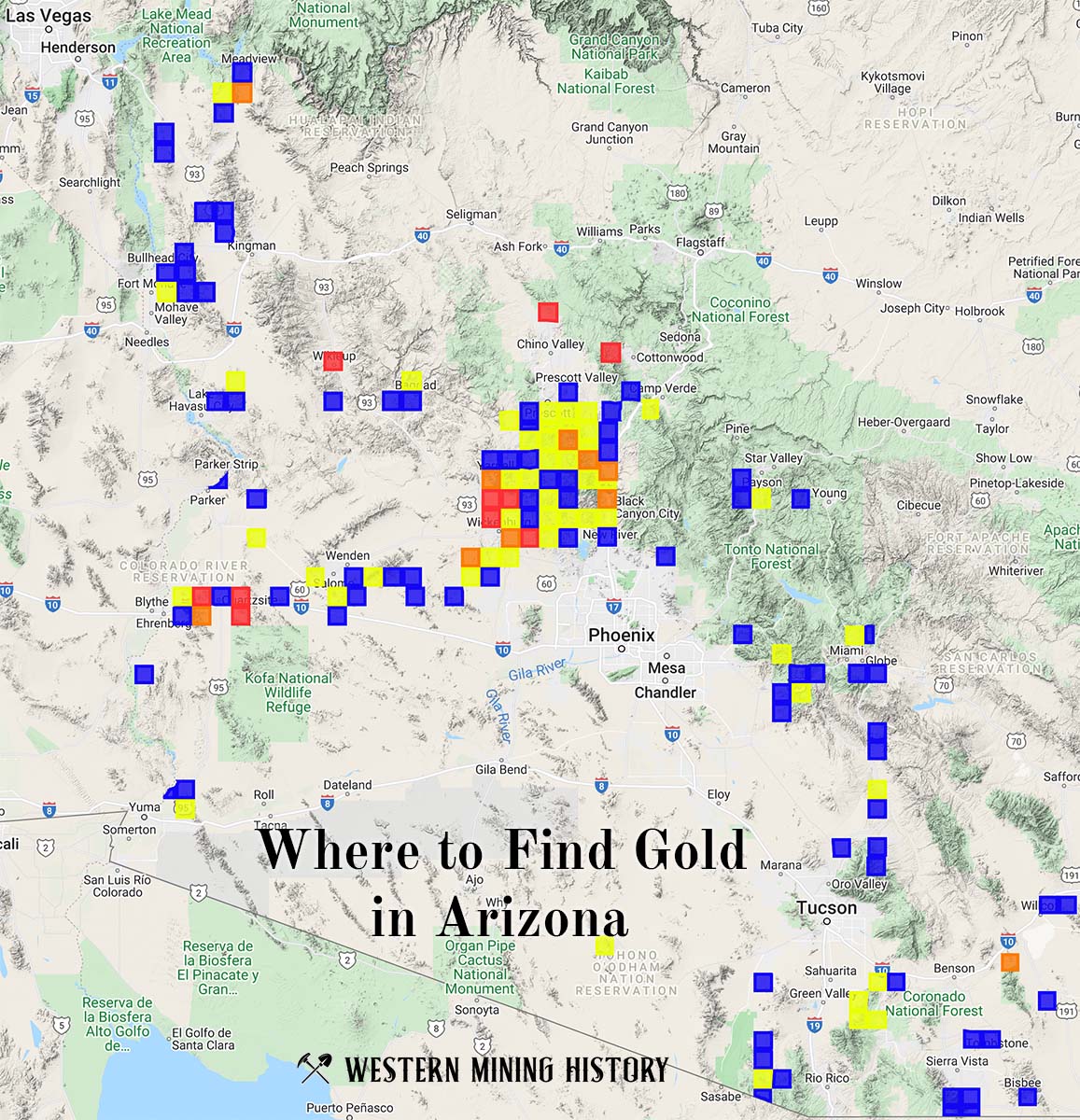The Golden Turkey Mine is a gold and silver mine located in Yavapai county, Arizona at an elevation of 3,100 feet.
About the MRDS Data:
All mine locations were obtained from the USGS Mineral Resources Data System. The locations and other information in this database have not been verified for accuracy. It should be assumed that all mines are on private property.
Mine Info
Elevation: 3,100 Feet (945 Meters)
Commodity: Gold, Silver
Lat, Long: 34.26806, -112.20417
Map: View on Google Maps
Mine Description
The Golden Turkey mine, held by H. C. Mitchell and associates, is on the west side of Turkey Creek, near the eastern foot of the Bradshaw Mountains, at an elevation of about 3,000 feet. Via the Black Canyon Highway, the property is about 15 miles from Mayer, the nearest railway shipping point.
Some years ago, a 100-foot shaft was sunk on the property, but no production was made until 1933 when the workings were extended, and more than 4,000 tons of ore were run through the Golden Belt mill. The monthly yield was approximately two cars of concentrates containing gold and silver together with some zinc and a little copper. Several shipments of smelting ore also were made.
Here, pre-Cambrian schist strikes northward and dips almost vertically. The vein, which strikes northeastward and ranges in dip from 30° to less than 10° S.E., occupies a fissure zone that is probably due to thrust faulting. As exposed, the vein ranges from a few inches to more than a foot in width and in places forms a branching lode several feet wide. The vein filling consists of very coarsely crystalline, milky to clear, glassy quartz together with rather abundant irregular masses and disseminations of pyrite, galena, and sphalerite. In places, a little chalcopyrite is present. The gold accompanies the sulphides, particularly the pyrite. The vein walls show rather intense sericitization and silification and in places contain disseminated metacrysts of practically barren pyrite.
When visited in January, 1934, developments consisted of a 500-foot inclined shaft and approximately 2,000 feet of workings. Most of the ore mined has come from below the 350-foot level, particularly where the vein flattens in dip. According to Mr. Mitchell,(63) the oxidized zone extended to a depth of approximately 250 feet on the incline.
(63) Oral communication.
Text from Arizona Lode Gold Mines and Gold Mining, Arizona Bureau of Mines. Original 1934, revised 1967
Golden Turkey Mine MRDS details
Site Name
Primary: Golden Turkey Mine
Commodity
Primary: Gold
Primary: Silver
Secondary: Lead
Secondary: Copper
Secondary: Zinc
Location
State: Arizona
County: Yavapai
District: Black Canyon District
Land Status
Land ownership: National Forest
Note: the land ownership field only identifies whether the area the mine is in is generally on public lands like Forest Service or BLM land, or if it is in an area that is generally private property. It does not definitively identify property status, nor does it indicate claim status or whether an area is open to prospecting. Always respect private property.
Holdings
Not available
Workings
Type: Underground
Ownership
Owner Name: Mr. And . Manley
Years: 1969 -
Owner Name: G. Pye; O.S. Cassiby
Years: 1968 -
Production
Not available
Deposit
Record Type: Site
Operation Category: Past Producer
Operation Type: Unknown
Year First Production: 1923
Year Last Production: 1949
Discovery Year: 1900
Years of Production:
Organization:
Significant: N
Deposit Size: S
Physiography
General Physiographic Area: Intermontane Plateaus
Physiographic Province: Basin And Range Province
Physiographic Section: Mexican Highland
Mineral Deposit Model
Not available
Orebody
Form: TABULAR
Structure
Type: R
Description: Foliation And Transposed Bedding In Metavolcanic Rocks Trends N-S
Type: L
Description: Low-Angle (Less Than 40 Deg) Veins Cut Across Foliation
Alterations
Not available
Rocks
Name: Andesite
Role: Associated
Age Type: Host Rock Unit
Age in Years: 1720.000000+-
Dating Method: U-Pb (zircon)
Material Analyzed: Zircon
Age Young: Proterozoic
Name: Schist
Role: Host
Age Type: Host Rock Unit
Age in Years: 1720.000000+-
Dating Method: U-Pb (zircon)
Material Analyzed: Zircon
Age Young: Proterozoic
Name: Andesite
Role: Host
Age Type: Host Rock Unit
Age in Years: 1720.000000+-
Dating Method: U-Pb (zircon)
Material Analyzed: Zircon
Age Young: Proterozoic
Name: Diorite
Role: Associated
Age Type: Associated Rock
Age Young: Pliocene
Name: Diorite
Role: Associated
Age Type: Host Rock Unit
Age Young: Neoproterozoic
Analytical Data
Analytical Data: 0.75 % CU
Analytical Data: 4.75 % PB
Analytical Data: 50 OZ. AG/TON
Analytical Data: 1935 AVERAGE ASSAYS: 2.10 OZ. AU/TON
Materials
Ore: Galena
Ore: Sphalerite
Ore: Chalcopyrite
Gangue: Quartz
Gangue: Calcite
Unknown: Pyrite
Comments
Comment (Deposit): THIS RECORD CONTAINS DATA FROM DUPLICATE RECORD D002805 OF J.W. HASLER WHICH HAS BEEN DELETED FROM MAIN MRDS. ; INFO.SRC : 1 PUB LIT; 2 UNPUB REPT
Comment (Geology): VEIN MAY OR MAY NOT BE SPATIALLY ASSOCIATED WITH DIORITE-BASALT DIKES OF PROBABLE MIOCENE AGE.
Comment (Deposit): DEPOSIT IS LOW-ANGLE QUARTZ VEIN WHICH CUTS PROTEROZOIC METAVOLCANIC ROCKS.
References
Reference (Deposit): ANDERSON, 1972, USGS BULL 1345, P. 34-35.
Reference (Other Database): CIMRI
Reference (Production): U.S.B.M. I.C. 6905 , P. 17 ; A.B.M. BULL. 137 , P. 52
Reference (Deposit): WILSON, E.D., 1934, ARIZONA LODE GOLD MINES AND GOLD MINING: ARIZONA BUREAU OF MINES BULLETIN 137, P. 51.
Reference (Deposit): GUITERAS, J.R., 1936, GOLD MINING AND MILLING IN THE BLACK CANYON AREA, YAVAPAI COUNTY, ARIZONA: U.S.B.M. INFORMATION CIRCULAR 6905, P. 14.
Reference (Deposit): ABGMT CLIPPINGS FILES.
Reference (Deposit): ABGMT-USBM FILE DATA.
Reference (Deposit): ARIZONA DEPT OF MINERAL RESOURCES FILE DATA.
Arizona Gold

"Where to Find Gold in Arizona" looks at the density of modern placer mining claims along with historical gold mining locations and mining district descriptions to determine areas of high gold discovery potential in Arizona. Read more: Where to Find Gold in Arizona.